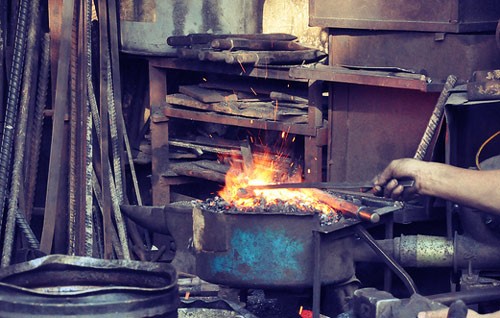(VOVworld) - Giàng A Dia in Hong Ngai commune, Son La province, is well-known for preserving the traditional craft of forging of the Mong ethnic minority people. Dia’s knives and ploughs are popular not only among local people and throughout Vietnam.
For several years, the ring of the Dia family’s blacksmith shop has echoed on the Hong Ngai mountain. It’s a typical sound here. This is the only family in the area that still pursues the traditional Mong forging craft.
Dia says the metal work style has been handed down for generations and that he learned it from his grandfather and father when he was small. He still follows the trade with great interest. He started out just making knives and ploughs for personal use. Dia now owns a forging workshop employing several local Mong people. Giàng A Lử also lives in Hong Ngai commune: “I really want my children and other younger people in the hamlet to learn this occupation. This job can bring them income and at the same time preserve this traditional Mong craft”.
 |
Giàng A Dia says forging tools is very simple. Just some hammers, anvils, a clay furnace, coal and an iron cutter. Before forging a knife, it is necessary to prepare the furnace and coal. The coal must come from a special type of wood which makes the fire sufficiently hot. Dia says first, it is necessary to cut a piece of iron and then heat it in the furnace for 30 minutes. This work has become easier now thanks to the mechanical iron cutter. When the iron is incandescent, the forger beats the iron until it cools and then puts it back in the furnace. This process is repeated 7 or 8 times until the product is shaped. After that, the knife or the plough is soaked in water to harden it. This process - called iron tempering step - is different depending on the type of iron. According to Giang A Dia, some iron is tempered in water with a little bit salt while other types are tempered with a banana tree trunk. Next, the tools are sharpened. Mong people used to use stones taken from a stream. Now, they have grinders. Dia says this meticulous forging process is what makes Mong tools superior: “The forging process must follow those particular steps. This is our traditional craft and we never miss any step in that process. That’s why knives and ploughs made by Mong people are better, sharper, more durable and thicker than others in the market. Many people like our products”.
The work is labor-intensive so Dia can only forge one or two knives a day. The forging workshop produces 3-4 knives and ploughs a day, each of them between about 70 cents and 1 USD. There are some days that Dia does not sell any. Still, Dia’s passion for making tools for his neighbors never wanes. He says he really hopes the State will help Mong people restore this occupation, which would create more jobs. “No one in my hamlet has a furnace or knows about the forging craft. I really want to teach the craft to my neighbors to preserve our tradition”.
The traditional craft of the Mong ethnic minority people combines patience, creativity and the skills of the blacksmith. The reason Giang A Dia wants to practice the craft and teach it to his neighbors is so this traditional occupation will not disappear.